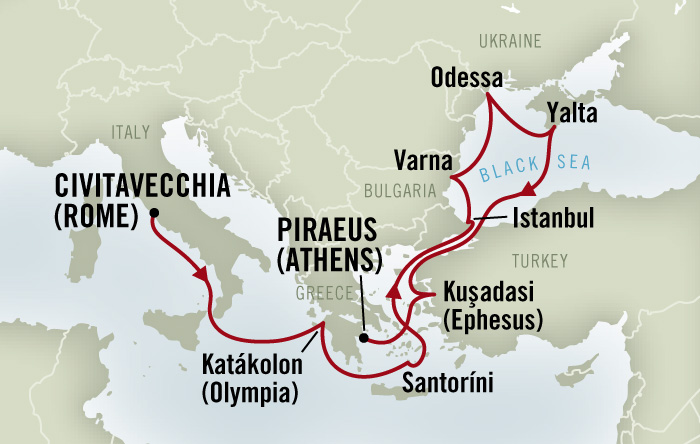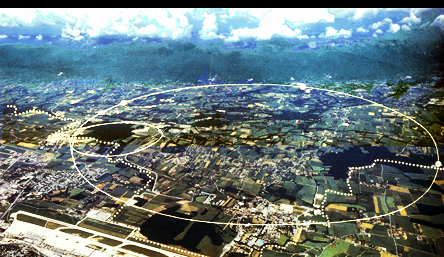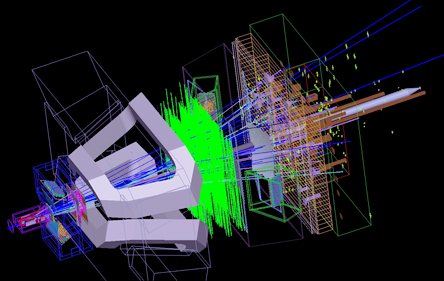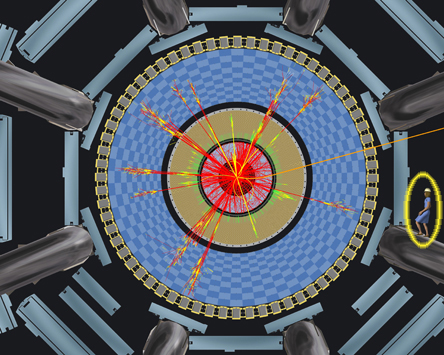![]()
![]()
| DAY | PORT | ARRIVE | DEPART | CONFERENCE SESSIONS | |
| SATURDAY, OCT. 1 | CIVITAVECCHIA (ROME), ITALY | — | 5pm | 7pm, BON VOYAGE COCKTAIL PARTY | |
| SUNDAY, OCT. 2 | AT SEA | — | — | 8:30am – 5pm | |
| MONDAY, OCT. 3 | KATAKOLON, GREECE | 8am | 4pm | 4pm – 7:30pm | |
| TUESDAY, OCT. 4 | THIRA (SANTORINI), GREECE | 8am | 5pm | 5pm – 7:30pm | |
| WEDNESDAY, OCT. 5 | ISTANBUL, TURKEY | 4pm | — | 8:30am – Noon; 1:30pm – 3pm | |
| THURSDAY, OCT. 6 | ISTANBUL, TURKEY | — | 5pm | 5pm – 7:30pm | |
| FRIDAY, OCT. 7 | VARNA, BULGARIA | 8am | 3pm | 3:30pm – 5pm; 6pm – 7:30pm | |
| SATURDAY, OCT. 8 | ODESSA, UKRAINE | 8am | 5pm | 5pm – 7:30pm | |
| SUNDAY, OCT. 9 | YALTA, UKRAINE | 8am | 5pm | 5pm – 7:30pm | |
| MONDAY, OCT. 10 | AT SEA | — | — | 8:30am – Noon & 1:30pm – 5pm | |
| TUESDAY, OCT. 11 | KUSADASI (EPHESUS), TURKEY | 8am | 5pm | 5pm – 7:30pm | |
| WEDNESDAY, OCT. 12 | PIRAEUS (ATHENS), GREECE | 8am | overnight | — | |
| THURSDAY, OCT. 13 | PIRAEUS (ATHENS), GREECE | — | 7am | — |

From the tiniest constituents of matter to the immensity of the cosmos, discover the wonders of science and technology at CERN. Join Bright Horizons for a private pre-cruise, custom, full-day tour of this iconic facility.
Whether you lean toward concept or application there’s much to pique your curiousity. Discover the excitement of fundamental research and get a behind-the-scenes, insider’s look of the world’s largest particle physics laboratory.
Our full day will be led by a CERN official and physicist. We’ll have an orientation; visit an accelerator and experiment; get a sense of the mechanics of the large hadron collider (LHC); make a refueling stop for lunch in the Globe of Science and Innovation; and have time to peruse exhibits and media on the history of CERN and the nature of its work.
To take advantage of this unrivaled insider access to CERN, rendezvous with Bright Horizons on September 27, 2011 in Geneva, Switzerland. For evolving details, please contact Neil or Theresa, or give us a call at (650) 787-5667.
The six experiments at the LHC are all run by international collaborations, bringing together scientists from institutes all over the world. Each experiment is distinct, characterised by its unique particle detector.
The two large experiments, ATLAS and CMS, are based on general-purpose detectors to analyse the myriad of particles produced by the collisions in the accelerator. They are designed to investigate the largest range of physics possible. Having two independently designed detectors is vital for cross-confirmation of any new discoveries made.
Two medium-size experiments, ALICE and LHCb, have specialised detectors for analysing the LHC collisions in relation to specific phenomena.
Two experiments, TOTEM and LHCf, are much smaller in size. They are designed to focus on ‘forward particles’ (protons or heavy ions). These are particles that just brush past each other as the beams collide, rather than meeting head-on.
The ATLAS, CMS, ALICE and LHCb detectors are installed in four huge underground caverns located around the ring of the LHC. The detectors used by the TOTEM experiment are positioned near the CMS detector, whereas those used by LHCf are near the ATLAS detector.
(From CERN’s website.)
The European Organization for Nuclear Research, known as CERN, is the world’s largest particle physics laboratory, situated in the northwest suburbs of Geneva on the Franco-Swiss border, established in 1954. The organization has twenty European member states, and is currently the workplace of approximately 2,600 full-time employees, as well as some 7,931 scientists and engineers (representing 580 universities and research facilities and 80 nationalities).
CERN’s main function is to provide the particle accelerators and other infrastructure needed for high-energy physics research. Numerous experiments have been constructed at CERN by international collaborations to make use of them. It is also noted for being the birthplace of the World Wide Web.
As an international facility, CERN is officially under neither Swiss nor French jurisdiction. Member states’ contributions to CERN for the year 2008 totalled approximately € 700 million.




264 S. Meridith Ave., Pasadena, CA 91106 • 650-787-5665 • Copyright 2010 © InSight Cruises • Scientific American is a trademark of Nature America, Inc.